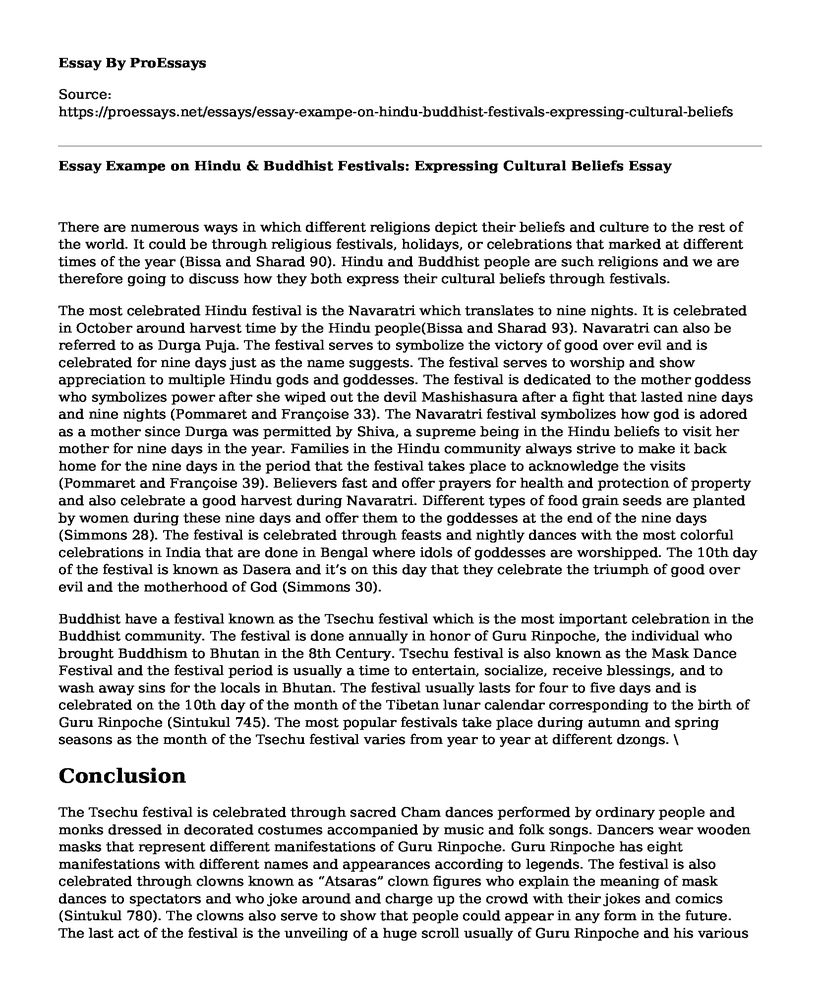There are numerous ways in which different religions depict their beliefs and culture to the rest of the world. It could be through religious festivals, holidays, or celebrations that marked at different times of the year (Bissa and Sharad 90). Hindu and Buddhist people are such religions and we are therefore going to discuss how they both express their cultural beliefs through festivals.
The most celebrated Hindu festival is the Navaratri which translates to nine nights. It is celebrated in October around harvest time by the Hindu people(Bissa and Sharad 93). Navaratri can also be referred to as Durga Puja. The festival serves to symbolize the victory of good over evil and is celebrated for nine days just as the name suggests. The festival serves to worship and show appreciation to multiple Hindu gods and goddesses. The festival is dedicated to the mother goddess who symbolizes power after she wiped out the devil Mashishasura after a fight that lasted nine days and nine nights (Pommaret and Françoise 33). The Navaratri festival symbolizes how god is adored as a mother since Durga was permitted by Shiva, a supreme being in the Hindu beliefs to visit her mother for nine days in the year. Families in the Hindu community always strive to make it back home for the nine days in the period that the festival takes place to acknowledge the visits (Pommaret and Françoise 39). Believers fast and offer prayers for health and protection of property and also celebrate a good harvest during Navaratri. Different types of food grain seeds are planted by women during these nine days and offer them to the goddesses at the end of the nine days (Simmons 28). The festival is celebrated through feasts and nightly dances with the most colorful celebrations in India that are done in Bengal where idols of goddesses are worshipped. The 10th day of the festival is known as Dasera and it’s on this day that they celebrate the triumph of good over evil and the motherhood of God (Simmons 30).
Buddhist have a festival known as the Tsechu festival which is the most important celebration in the Buddhist community. The festival is done annually in honor of Guru Rinpoche, the individual who brought Buddhism to Bhutan in the 8th Century. Tsechu festival is also known as the Mask Dance Festival and the festival period is usually a time to entertain, socialize, receive blessings, and to wash away sins for the locals in Bhutan. The festival usually lasts for four to five days and is celebrated on the 10th day of the month of the Tibetan lunar calendar corresponding to the birth of Guru Rinpoche (Sintukul 745). The most popular festivals take place during autumn and spring seasons as the month of the Tsechu festival varies from year to year at different dzongs. \
Conclusion
The Tsechu festival is celebrated through sacred Cham dances performed by ordinary people and monks dressed in decorated costumes accompanied by music and folk songs. Dancers wear wooden masks that represent different manifestations of Guru Rinpoche. Guru Rinpoche has eight manifestations with different names and appearances according to legends. The festival is also celebrated through clowns known as “Atsaras” clown figures who explain the meaning of mask dances to spectators and who joke around and charge up the crowd with their jokes and comics (Sintukul 780). The clowns also serve to show that people could appear in any form in the future. The last act of the festival is the unveiling of a huge scroll usually of Guru Rinpoche and his various manifestations. Believers from different corners of Bhutan show up in the morning and come together to receive blessings from it. For the people attending the festival, it is an important part of the spiritual devotion of Buddhism. They believe that through the festival one can accumulate spiritual gain and enlightenment which is the ultimate goal for Buddhists.
Works Cited
Bissa, Sharad. "Agnihotra: A boon to humanity." International Education and Research Journal 1.5 (2015): 93-94.
Pommaret, Françoise. "A Cultural Epiphany: Religious Dances of Bhutan and Their Costumes." MARG-A MAGAZINE OF THE ARTS 66.4 (2015): 30-39.
Simmons, Caleb, Moumita Sen, and Hillary Rodrigues, eds. Nine Nights of the Goddess: The Navaratri Festival in South Asia. SUNY Press, 2018.
Suntikul, Wantanee, and Ugyen Dorji. "Local perspectives on the impact of tourism on religious festivals in Bhutan." Asia Pacific Journal of tourism research 21.7 (2016): 741-762.
Cite this page
Essay Exampe on Hindu & Buddhist Festivals: Expressing Cultural Beliefs. (2023, Sep 02). Retrieved from https://proessays.net/essays/essay-exampe-on-hindu-buddhist-festivals-expressing-cultural-beliefs
If you are the original author of this essay and no longer wish to have it published on the ProEssays website, please click below to request its removal:
- Essay Sample on Islamic Art
- Religion Essay Example on Paul's Missions
- Letter on Difference in Traditions Between America and India
- Obedience to God and Morality Essay
- Emergency Management of "Deep Horizon" Event
- Article Analysis Essay on Spirituality and Religion in Counselling
- Paper Example on Colonel Bradford's Family Safety Priority During Plague







